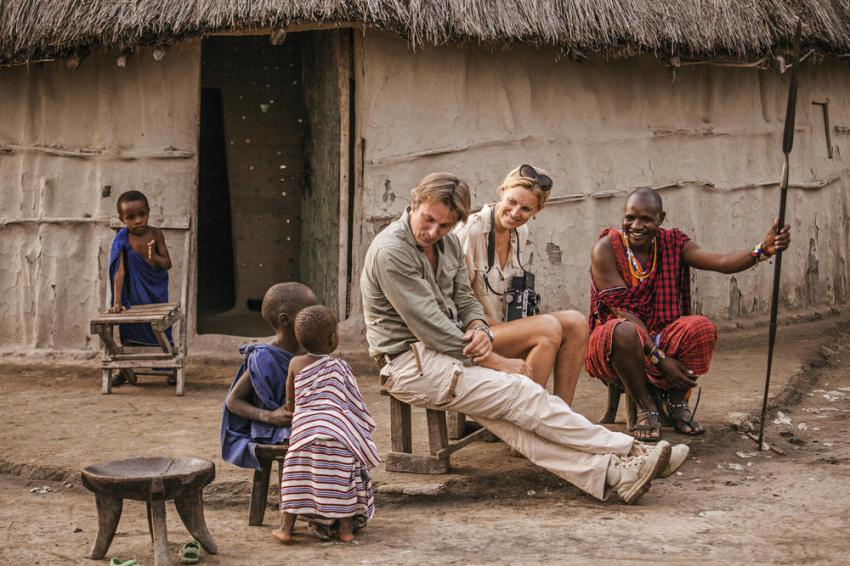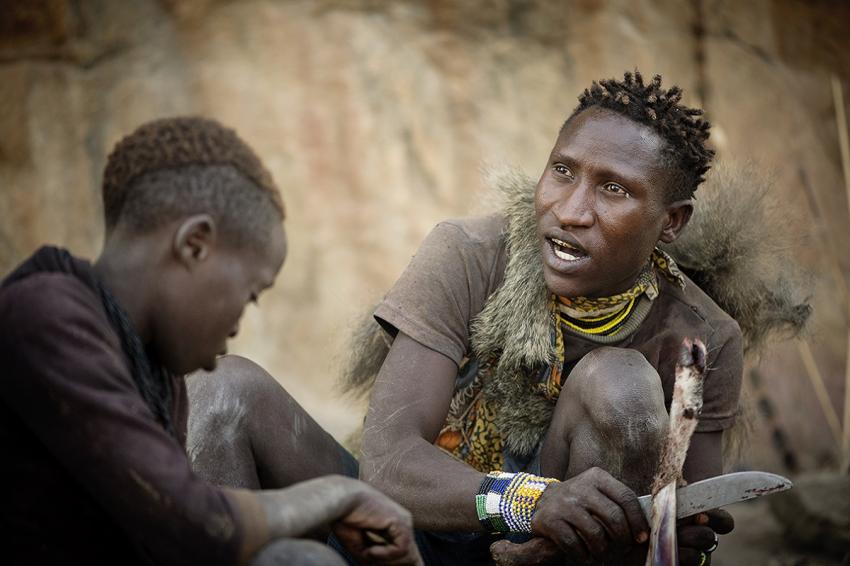Situated on the southern edge of the UNESCO World Heritage-listed Ngorongoro Conservation Area, Lake Eyasi is a seasonal, shallow endorheic salt lake on the floor of the Great Rift Valley. Elongated southwest to northeast, it’s framed by the Eyasi escarpment to the north and the Kidero Mountains in the south, with a remote, otherworldly feel. Lake Eyasi’s landscape is completely different from the surrounding savannah you might experience on a Serengeti safari, with palm trees and sandpaper bushes fringing the waters to create a somewhat tropical setting.
While thousands of visitors explore the iconic Serengeti National Park and wildlife-filled Ngorongoro Crater each year on a Tanzania safari package, few venture to this stunning natural wonder that lies nearby. It’s accessed along a bumpy road from the town of Karatu (which serves as the gateway to the Ngorongoro Crater) and can easily be combined on a Northern Circuit Tanzania safari itinerary.
Wildlife spotting at Lake Eyasi
While Lake Eyasi doesn’t support the big-game wildlife populations seen in the neighbouring parks and conservation areas, it is a birdwatchers dream. The shallow waters support a huge diversity of breeding waterbirds from June to November, including large populations of flamingos and pelicans. Hippos are also known to come and wallow in the waters when the lake is full while a number of other wildlife species frequent the springs in the surrounding region.
But Lake Eyasi transforms dramatically with the seasons, taking on an otherworldly appearance during the dry season when it all but dries up. Photographers are lured here to capture its surreal landscapes while history buffs will be fascinated by the ancient rock art sites that were created hundreds of years ago by ancestral tribes. The shores of Lake Eyasi are home to the Mumba Cave, an archaeological site where numerous Stone Age artefacts have been uncovered.
Lake Eyasi is a spectacular area to explore on foot and wildly peaceful, standing in stark contrast to the crowded wildlife encounters in the Seronera area of the Serengeti or inside the Ngorongoro Crater.
Cultural encounters at Lake Eyasi

Lake Eyasi and its surrounds have long been home to Tanzania’s indigenous tribes, with the Hadzabe foragers and Datoga herders co-existing here for centuries. While the Hadzabe have traditionally inhabited the lake shores, the Datoga are mainly centred in the Yaeda Valley to the southeast. Also nearby live the Iraqw people, as well as the Sukuma tribe across the Sibiti River to the southwest. A Tanzania safari tour incorporating Lake Eyasi offers a unique opportunity to connect with these tribes and learn about their long-established traditions.
Hadzabe people

The Hadzabe hunter-gatherers are one of East Africa’s oldest tribes and number around 1,000 in Tanzania. They’ve lived sustainably on their lands near the Rift Valley for over 50,000 years, with the men hunting big game and sourcing honey while the women gather fruits, tubers and berries to complement their diet. The Hadzabe hunt using strong bows that are made from giraffe tendons and arrows that are treated with poison.
In Hadzabe culture, they don’t “own” anything and exist with minimal belongings (such as cooking utensils) while living in harmony with their supporting environment. Their language is similar to the click-style dialogue that’s spoken by the Bushmen of Southern Africa while their belief system centres around mythological figures and the concept of “Epeme” (“manhood”).
Datoga people

The Datoga are a pastoralist Nilotic people who are divided into numerous tribes that speak dialects so convergent that conversations between the tribes can be difficult. Cattle lies at the centre of Datoga life, providing milk, meat and occasionally blood for sustenance. Skins are used for clothing while horns are transformed into drinking vessels and dung is used in the construction of dwellings.
The Datoga are also renowned as skilled silversmiths, crafting iron tips, knives and spears that are often traded with the Hadzabe people in exchange for honey or fruits. Their traditional dress is commonly decorated in colourful beads and the women often scar themselves in a display of beauty.
Sukuma people
The Sukuma are Tanzania’s largest tribal group, with around 5.5 million within the country. The name “Sukuma” translates as “north”, with the majority living in rural areas throughout Tanzania’s northern regions. They’re a predominantly matriarchal society (although polygamy is still a standard practice amongst many) and have traditionally worshipped the spirits of their ancestors in the belief that they will contribute to the health and success of living family members.
The Sukuma can roughly be divided into two distinct groups - the Kimakia and the Kisomayo. Both groups speak the Sukuma language and share some cultural similarities with the Nyamwezi with whom they lived geographically close to for many years. Their economy is based on raising livestock and growing crops, with both plants and animals utilised in traditional medicine.
Iraqw
Numbering around 350,000 in Tanzania, the Iraqw people are a Cushitic-speaking tribal group who are concentrated in the landscapes just south of the Ngorongoro Crater. Historians believe they may be the descendants of the Neolithic Afro-Asiatic people who first introduced domesticated plants and animals to the Great Lakes Region. They speak the Iraqw language, although its use is in decline as Swahili increases in importance throughout Tanzania.
The Iraqw are renowned for their sharply defined features and shyness, with many only trading their cattle or crops when it’s absolutely necessary. Unlike many of the other tribal groups that inhabit Northern Tanzania, the Iraqw are rarely visited, despite most people driving through Iraqw territory at some point during their Tanzania safari. If you do get the chance to visit, the Iraqw men are known for being skilled blacksmiths while many of the women craft beautiful ceramic items.
When to visit Lake Eyasi
Lake Eyasi is highly seasonal, transforming from a bird-filled watering hole to a dry lake bed, depending on what time of the year you visit. While the dry months of June to October are generally considered the best time to visit Northern Tanzania (with reduced vegetation making for easy wildlife sightings and clear, sunny skies), Lake Eyasi almost completely dries out during this period. That being said, it’s still incredibly photogenic and you won’t miss out on any of the cultural encounters for which the reason in renowned. In fact, you might even see the Hadzabe and Datoga people crossing the lake on foot!
The short rains fall in Northern Tanzania during November and December, followed by the long rains from March to May. At these times, Lake Eyasi fills with shallow water and birds arrive from near and far to breed. These months are the ideal time to visit for birdwatchers wanting to witness a diverse range of species without the crowds experienced in Tanzania’s more popular national parks and wildlife reserves.
Where to stay

Situated on an escarpment overlooking Lake Eyasi, the Ziwani Lodge is a unique eco-lodge that provides the perfect base for exploring this natural wonder. It boasts incredible views across the Rift Valley and a serene atmosphere for travellers wanting to get away from it all. Overnight in one of the beautifully crafted rooms inspired by the local architecture, with the lodge running entirely on solar and wind power.
The Ziwani Lodge offers a range of excursions and activities for experiencing everything Lake Eyasi has to offer. Spend your days hiking to ancient rock art sites, birdwatching along the lake shores or meeting the Hadzabe and Datoga people. A visit to the Ziwani Lodge and Lake Eyasi is the ideal way to spend a few days after a concentrated wildlife safari in the Serengeti or Ngorongoro Crater.

 1-321-766-6821
1-321-766-6821 







